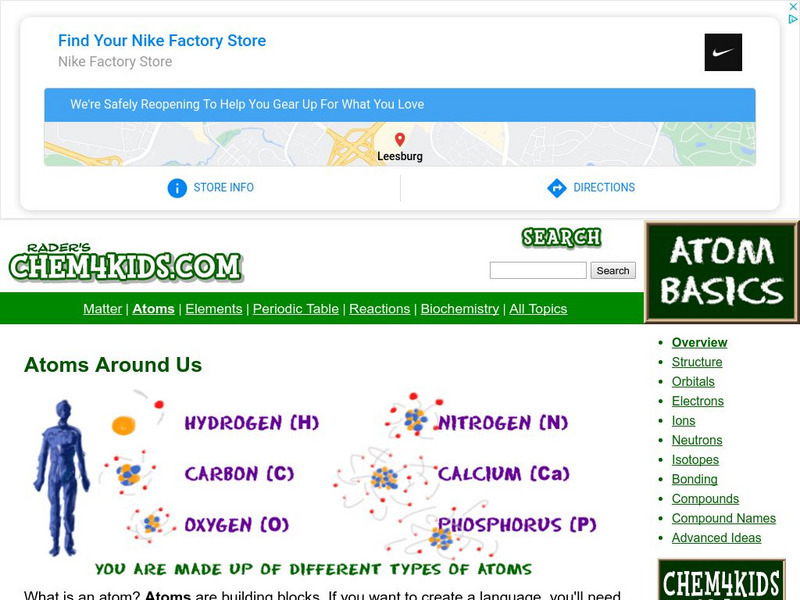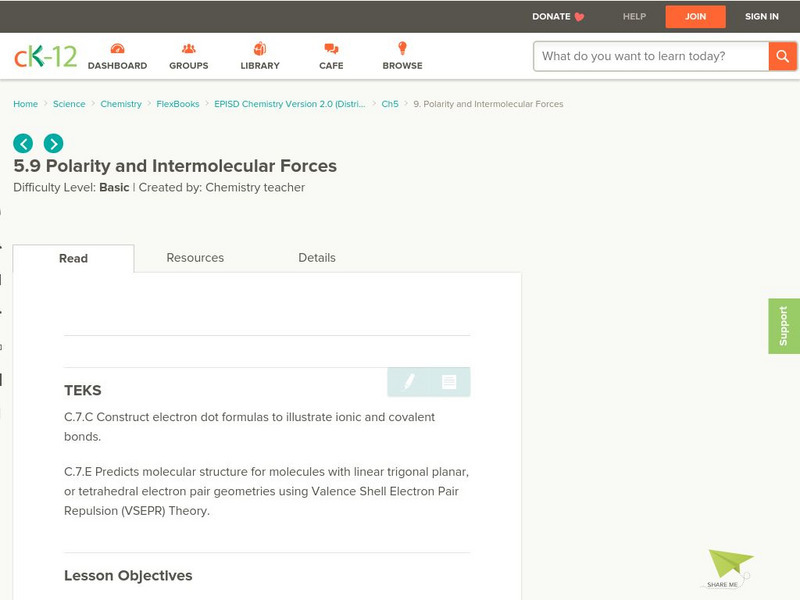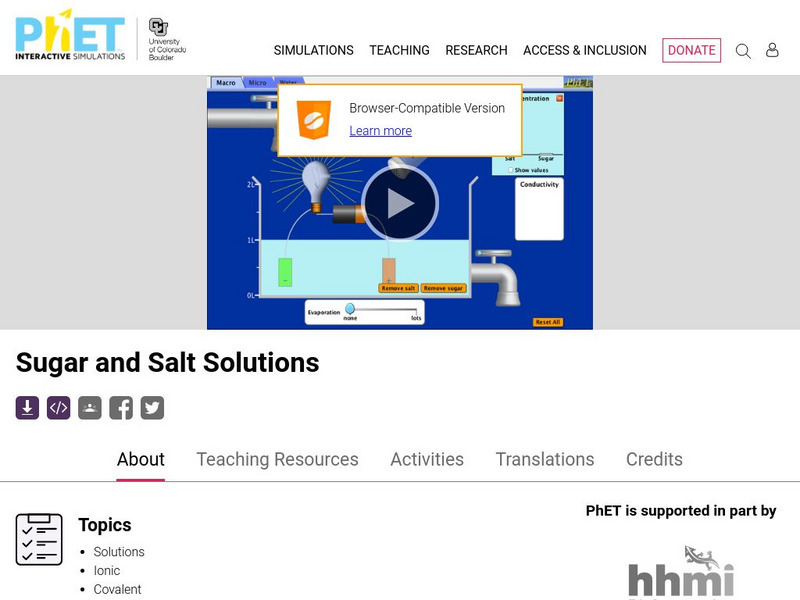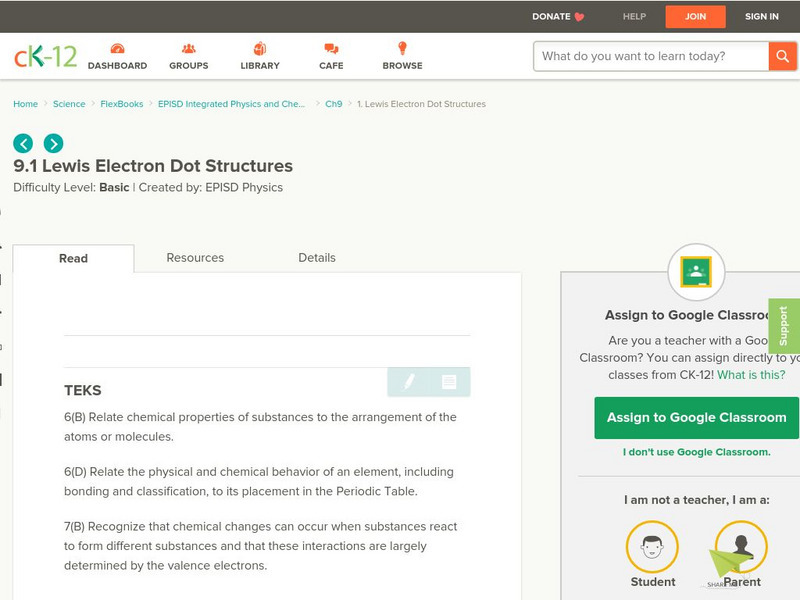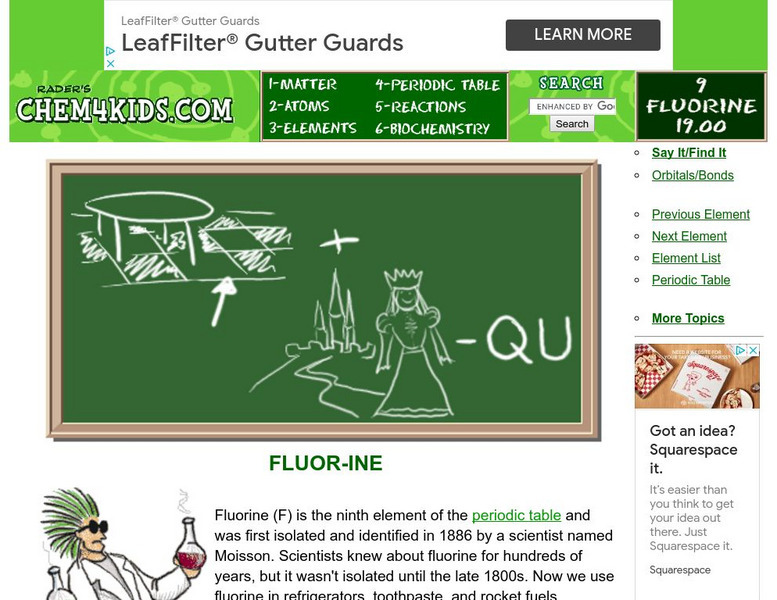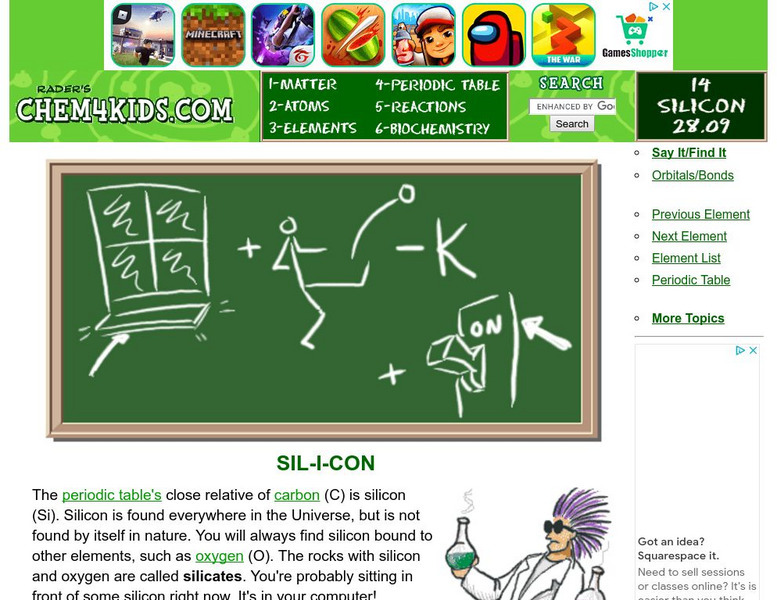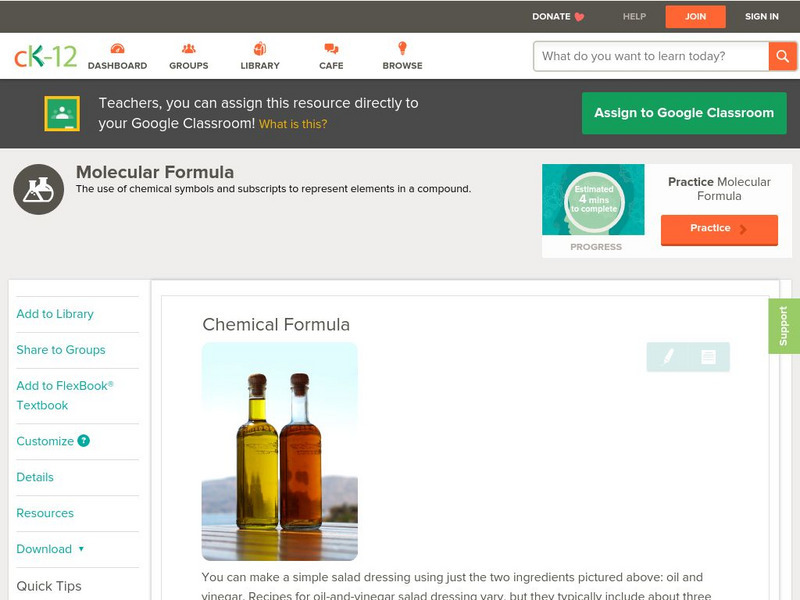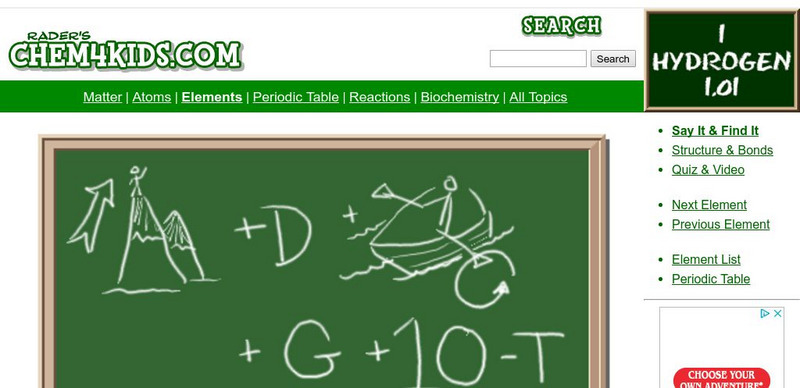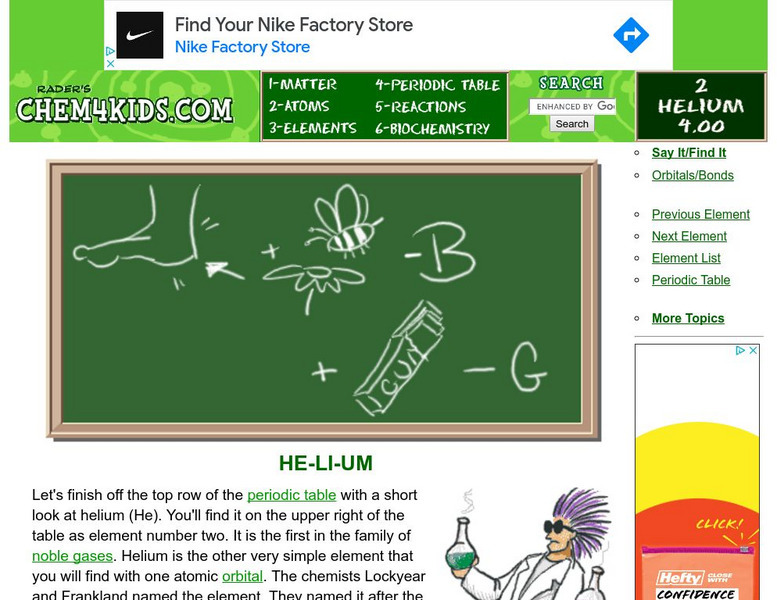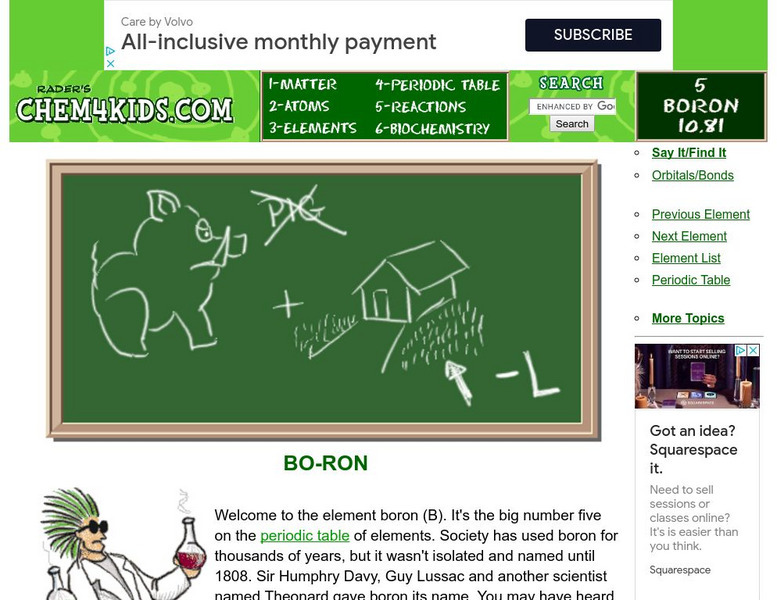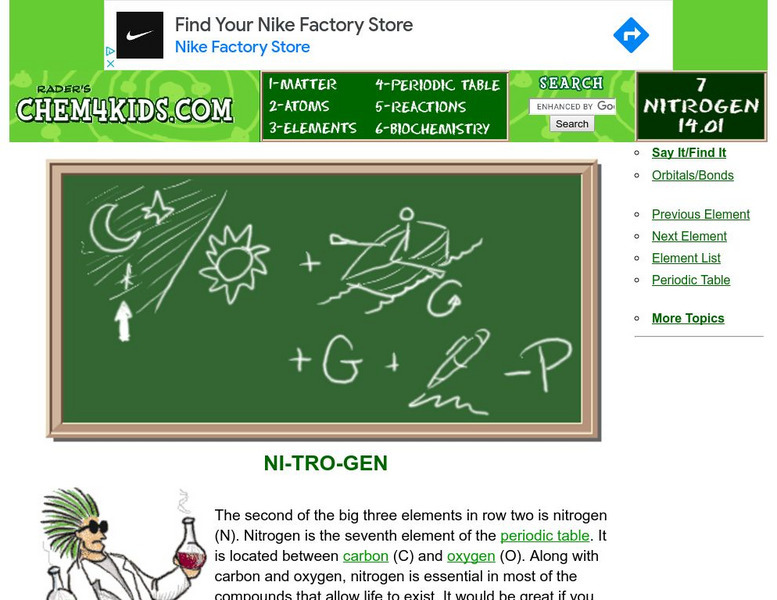Hi, what do you want to do?
Chem4kids
Chem4 Kids: Atoms
This site provides a detailed overview of atoms. Content explores an atom's structure, as well as what ions are, how atoms bond, what compounds are (including how to name compounds), and what isotopes are.
Other
University of Texas at Dallas: Attractions in Compounds
Explanation of attractive forces and energy changes involved in bonding.
Chiral Publishing
Chiral Publishing: An Introduction to Chemistry: Compounds and Chemical Bonds: Audio Book
Did you ever wonder how or why atoms bond together? This interactive tutorial sheds some light on why bonds form and the difference between ionic and covalent bonds.
CK-12 Foundation
Ck 12: Polarity and Intermolecular Forces
[Free Registration/Login may be required to access all resource tools.] The following online tutorial describes how the electronegativity difference between two atoms in a covalent bond results in the formation of a nonpolar covalent,...
University of Colorado
University of Colorado: Ph Et Interactive Simulations: Sugar and Salt Solutions
What happens when sugar and salt are added to water? Pour in sugar, shake in salt, and evaporate water to see the effects on concentration and conductivity. Zoom in to see how different sugar and salt compounds dissolve. Zoom in again to...
PBS
Pbs Learning Media: Chemical Bonds
This interactive activity developed for Teachers' Domain demonstrates how attractive forces between atoms create chemical bonds, resulting in the formation of molecules and compounds.
CK-12 Foundation
Ck 12: Lewis Electron Dot Structures
[Free Registration/Login may be required to access all resource tools.] Students will use their knowledge of covalent bonds, and apply that to drawing Lewis dot structures to represent compounds.
Utah Education Network
Uen: Conductivity and Bonding
Learners will measure the conductivity of several compounds and solutions in order to predict the bond types (ionic or covalent) in the substances tested.
Khan Academy
Khan Academy: Bond Hybridization
Practice determining the hybridization for atoms in covalent compounds.
Chem4kids
Chem4 Kids: Fluorine
Here you can find some great information about the 9th element in the periodic table, "fluorine." Content focuses on fluorine's electrons, where you can find fluorine in nature and in the home, and how fluorine combines with other elements.
Chem4kids
Chem4 Kids: Silicon (Si)
Here you can find some great information about the 14th element in the periodic table, "silicon." Content focuses on silicon's electrons, where you can find silicon in nature and in the home, and how silicon combines with other elements.
University of Arizona
Ua: Chemistry Tutorial
This general tutorial begins with an explanation of the polarity of the water molecule and the effects this polarity has on the properties of water. Goes on to introduce organic molecules and has a thourough tutorial on the third page.
CK-12 Foundation
Ck 12: Physical Science: Chemical Formula
[Free Registration/Login may be required to access all resource tools.] How to write chemical formulae and what they represent about the substance.
Museum of Science
The Atom's Family: Mighty Molecules
In this activity, students construct models of molecules using marshmallows and gum drops.
Biology Pages
Kimball's Biology Pages: Electronegativity
This site, which is a personal site from Kimball's Biology, provides an overview with multiple examples of electronegativity.
Chem4kids
Chem4 Kids: Hydrogen
Here you can find out about hydrogen, the first element in the periodic table. Content includes shell information, where to find it in nature, and why it is helpful to us.
Chem4kids
Chem4 Kids: Helium
Here you can find lots of great information about helium. Learn about its electrons, where it exists in nature, and about the element itself!
Chem4kids
Chem4 Kids: Boron
Here at Chem4Kids.com you can find some great information about the 5th element in the periodic table, "boron." Content focuses on boron's electrons, where you can find boron in nature and in the home, and how boron combines with other...
Chem4kids
Chem4 Kids: Carbon
Click on the left navigation terms for some great information about the 6th element in the periodic table, "carbon." Content focuses on carbon's electrons, where you can find carbon in nature and in the home, and how carbon combines with...
Chem4kids
Chem4 Kids: Nitrogen (N)
Here you can find some great information about the 7th element in the periodic table, "nitrogen." Content focuses on nitrogen's electrons, where you can find nitrogen in nature and in the home, and how nitrogen combines with other elements.
Chem4kids
Chem4 Kids: Neon (Ne)
Here you can find some great information about the 10th element in the periodic table, "neon." Content focuses on neon's electrons, where you can find neon in nature and in the home, and how neon combines with other elements.
Chem4kids
Chem4 Kids: Sodium (Na)
Here at Chem4Kids you can find some great information about the 11th element in the periodic table, "sodium." Content focuses on sodium's electrons, where you can find sodium in nature and in the home, and how sodium combines with other...
Chem4kids
Chem4 Kids: Magnesium (Mg)
Here you can find some great information about the 12th element in the periodic table, "magnesium." Content focuses on magnesium's electrons, where you can find magnesium in nature and in the home, and how magnesium combines with other...
Chem4kids
Chem4 Kids: Sulfur (S)
Here you can find some great information about the 16th element in the periodic table, "sulfur." Content focuses on sulfur's electrons, where you can find sulfur in nature and in the home, and how sulfur combines with other elements.
Other popular searches
- Naming Covalent Compounds
- Ionic and Covalent Compounds
- Uses of Covalent Compounds
- Binary Covalent Compounds
- Covalent Compounds and Uses
- Covalent Compounds in Foods
- 79 Covalent Compounds
- Covalent Compounds Worksheet





